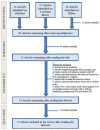Effectiveness of Therapeutical Interventions on the Scapulothoracic Complex in the Management of Patients with Subacromial Impingement and Frozen Shoulder: A Systematic Review
- PMID: 37092370
- PMCID: PMC10123708
- DOI: 10.3390/jfmk8020038
Effectiveness of Therapeutical Interventions on the Scapulothoracic Complex in the Management of Patients with Subacromial Impingement and Frozen Shoulder: A Systematic Review
Abstract
Shoulder pain is one the most common musculoskeletal complaints. The most common pathological causes of shoulder pain in the general population are subacromial impingement syndrome and adhesive capsulitis, commonly referred to as "frozen shoulder". The purpose of this study was to evaluate the role of the scapulo-thoracic complex, particularly in scapular kinematic functions, in rehabilitative interventions for shoulder pain in patients suffering from these two common conditions. This systematic review was performed using the scientific search engines PubMed, PEDro and Cochrane Library, considering only randomized controlled clinical trials. Selected articles were evaluated according to the level of evidence and methodological quality. Thirteen randomized clinical trials were selected. Interventions have been divided into three macro-categories: (1) manual therapy in patients with subacromial impingement, (2) therapeutic exercise programs including interventions on the scapulothoracic complex in patients with subacromial impingement syndrome, and (3) therapeutic exercise programs including interventions on the scapulothoracic complex in patients with frozen shoulder. Following this, a qualitative analysis was performed according to outcomes such as pain, shoulder function, and scapular kinematics. Physiotherapy exercise programs that included scapular motor control training and scapular mobilizations, in particular, those of the scapulo-thoracic complex in scapular kinematic function, represent valid alternatives in the management of patients with subacromial impingement syndrome.
Keywords: frozen shoulder; manual therapy; scapular function; scapular kinematics; shoulder pain; subacromial impingement syndrome.
Conflict of interest statement
The authors declare no conflict of interest.
Figures
Similar articles
-
Effect of scapular stabilization exercise program in patients with subacromial impingement syndrome: a systematic review.J Exerc Rehabil. 2020 Jun 30;16(3):216-226. doi: 10.12965/jer.2040256.128. eCollection 2020 Jun. J Exerc Rehabil. 2020. PMID: 32724778 Free PMC article. Review.
-
Is there evidence in favor of surgical interventions for the subacromial impingement syndrome?Clin J Sport Med. 2013 Sep;23(5):406-7. doi: 10.1097/01.jsm.0000433152.74183.53. Clin J Sport Med. 2013. PMID: 23989383
-
Immediate effect of scapula-focused exercises performed with kinematic biofeedback on scapular kinematics in individuals with subacromial pain syndrome.Clin Biomech (Bristol). 2018 Oct;58:7-13. doi: 10.1016/j.clinbiomech.2018.07.004. Epub 2018 Jul 5. Clin Biomech (Bristol). 2018. PMID: 30005425
-
Effects of Stretching and Strengthening Exercises, With and Without Manual Therapy, on Scapular Kinematics, Function, and Pain in Individuals With Shoulder Impingement: A Randomized Controlled Trial.J Orthop Sports Phys Ther. 2015 Dec;45(12):984-97. doi: 10.2519/jospt.2015.5939. Epub 2015 Oct 15. J Orthop Sports Phys Ther. 2015. PMID: 26471852 Clinical Trial.
-
Therapeutic Interventions for Scapular Kinematics and Disability in Patients With Subacromial Impingement: A Systematic Review.J Athl Train. 2019 Mar;54(3):283-295. doi: 10.4085/1062-6050-309-17. Epub 2019 Mar 4. J Athl Train. 2019. PMID: 30829536 Free PMC article.
Cited by
-
Nonsurgical Management of Shoulder Pain in Rotator Cuff Tears: Ultrasound-Guided Biceps Tenotomy Combined With Corticosteroid Injection.Arthrosc Tech. 2024 Jan 1;13(2):102847. doi: 10.1016/j.eats.2023.09.022. eCollection 2024 Feb. Arthrosc Tech. 2024. PMID: 38435258 Free PMC article.
-
The Clinical and Sonographic Features of Cervical Muscle Involvement in Patients with Frozen Shoulder: A Retrospective Study.Biomedicines. 2024 Oct 19;12(10):2395. doi: 10.3390/biomedicines12102395. Biomedicines. 2024. PMID: 39457706 Free PMC article.
-
Special Issue "Working Group in Sports Medicine".J Funct Morphol Kinesiol. 2024 Dec 31;10(1):12. doi: 10.3390/jfmk10010012. J Funct Morphol Kinesiol. 2024. PMID: 39846653 Free PMC article.
-
Effect of modified mobilization with movement and motor learning on volleyball females players with shoulder impingement syndrome.J Educ Health Promot. 2025 May 30;14:200. doi: 10.4103/jehp.jehp_1834_24. eCollection 2025. J Educ Health Promot. 2025. PMID: 40575530 Free PMC article.
-
The effects of telemedicine on Rotator cuff-related shoulder function and pain symptoms: a meta-analysis of randomized clinical trials.J Orthop Surg Res. 2024 Aug 14;19(1):478. doi: 10.1186/s13018-024-04986-4. J Orthop Surg Res. 2024. PMID: 39143625 Free PMC article.
References
-
- Kardouni J.R., Pidcoe P.E., Shaffer S.W., Finucane S.D., Cheatham S.A., Sousa C.O., Michener L.A. Thoracic Spine Manipulation in Individuals With Subacromial Impingement Syndrome Does Not Immediately Alter Thoracic Spine Kinematics, Thoracic Excursion, or Scapular Kinematics: A Randomized Controlled Trial. J. Orthop. Sports Phys. Ther. 2015;45:527–538. doi: 10.2519/jospt.2015.5647. - DOI - PubMed
-
- Habermeyer P., Lichtenberg S., Loew W., Magosch P., Martetschläger F., Tauber M. Schulterchirurgie. Elsevier; Berlin, Germany: 2017.
Publication types
LinkOut - more resources
Full Text Sources


